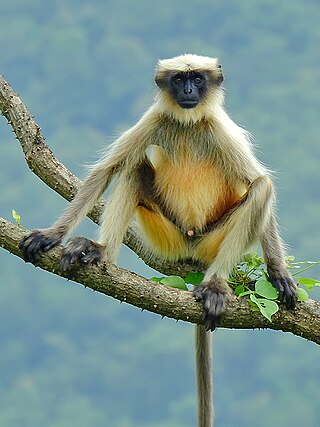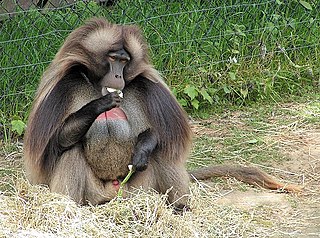
Old World monkey is the common English name for a family of primates known taxonomically as the Cercopithecidae. Twenty-four genera and 138 species are recognized, making it the largest primate family. Old World monkey genera include baboons, red colobus and macaques. Common names for other Old World monkeys include the talapoin, guenon, colobus, douc, vervet, gelada, mangabey, langur, mandrill, surili (Presbytis), patas, and proboscis monkey. Phylogenetically, they are more closely related to apes than to New World monkeys. They diverged from a common ancestor of New World monkeys around 45 to 55 million years ago.

The Colobinae or leaf-eating monkeys are a subfamily of the Old World monkey family that includes 61 species in 11 genera, including the black-and-white colobus, the large-nosed proboscis monkey, and the gray langurs. Some classifications split the colobine monkeys into two tribes, while others split them into three groups. Both classifications put the three African genera Colobus, Piliocolobus, and Procolobus in one group; these genera are distinct in that they have stub thumbs. The various Asian genera are placed into another one or two groups. Analysis of mtDNA confirms the Asian species form two distinct groups, one of langurs and the other of the "odd-nosed" species, but are inconsistent as to the relationships of the gray langurs; some studies suggest that the gray langurs are not closely related to either of these groups, while others place them firmly within the langur group.

Snub-nosed monkeys are a group of Old World monkeys and make up the entirety of the genus Rhinopithecus. The genus is rare and not fully researched. Some taxonomists group snub-nosed monkeys together with the genus Pygathrix.
Changqing National Nature Reserve is located near Huayang Village in the Qin Mountains of Shaanxi province of China.

The black-and-white snub-nosed monkey, also known as the Yunnan snub-nosed monkey, is a large black and white primate that lives only in the southern Chinese province of Yunnan, where it is known to the locals as the Yunnan golden hair monkey (滇金丝猴) and the black-and-white snub-nosed monkey (黑白仰鼻猴). The common name, black snub-nosed monkey, is issued to Rhinopithecus strykeri, inhabiting the Northern Sino-Myanmar border. Coniferous and deciduous forests in the mountainous regions of Yunnan are the ideal terrain for these primates. It is threatened by habitat loss, and is considered an endangered species. With their unique adaptations to their environment, these monkeys thrive at extreme altitudes despite the below freezing temperatures and thin air. This primate's diet is mainly made up of the large amounts of lichens available in their region.

The gray snub-nosed monkey, also known as Brelich's snub-nosed monkey, Guizhou snub-nosed monkey, and Guizhou golden monkey, is a species of primate in the family Cercopithecidae. It is endemic to China, where it is known as the Guizhou golden hair monkey (黔金丝猴) or gray golden hair monkey (灰金丝猴). It is threatened by habitat loss. Of the three species of snub-nosed monkeys in China, the gray snub-nosed monkey is the most threatened, with a total population thought to number fewer than 400 individuals.

The golden snub-nosed monkey is an Old World monkey in the subfamily Colobinae. It is endemic to a small area in temperate, mountainous forests of central and Southwest China. They inhabit these mountainous forests of Southwestern China at elevations of 1,500–3,400 m (4,900–11,200 ft) above sea level. The Chinese name is Sichuan golden hair monkey (四川金丝猴). It is also widely referred to as the Sichuan snub-nosed monkey. Of the three species of snub-nosed monkeys in China, the golden snub-nosed monkey is the most widely distributed throughout China.

The Fanjingshan or Mount Fanjing, located in Tongren, Guizhou province, is the highest peak of the Wuling Mountains in southeastern China, at an elevation of 2,570 m (8,430 ft). The Fanjingshan National Nature Reserve was established in 1978 and designated a UNESCO Biosphere Reserve in 1986. Fanjingshan is a sacred mountain in Chinese Buddhism, considered to be the bodhimaṇḍa of the Maitreya Buddha. It became a UNESCO World Heritage Site in 2018.

Ilex, or holly, is a genus of over 570 species of flowering plants in the family Aquifoliaceae, and the only living genus in that family. Ilex has the most species of any woody dioecious angiosperm genus. The species are evergreen or deciduous trees, shrubs, and climbers from tropics to temperate zones worldwide. The type species is Ilex aquifolium, the common European holly used in Christmas decorations and cards.

The Tonkin snub-nosed monkey or Dollman's snub-nosed monkey is a slender-bodied arboreal Old World monkey, endemic to northern Vietnam. It has black and white fur, a pink nose and lips, and blue patches around the eyes. It is found at elevations from 200 to 1,200 m on fragmentary patches of forest on craggy limestone areas. First described in 1912, the monkey was rediscovered in 1989 but is exceedingly rare. Out of the five snub-nosed monkey species in the world, the Tonkin snub-nosed monkey is the rarest. In 2008, fewer than 250 individuals were thought to exist, and the species was the subject of intense conservation effort. The main threats faced by these monkeys are habitat loss and hunting, and the International Union for Conservation of Nature has rated the species as "critically endangered".

One-male groups are a type of social organization where one male interacts with a group of females and their immature offspring. Offspring of both sexes are evicted from the group upon reaching puberty. It can be seen in many species of primates, including the gelada baboon, the patas monkey, savanna baboon, sun-tailed monkey, golden snub-nosed monkey, and the hamadryas baboon. There are costs and benefits for individuals living in one-male groups. As well, individuals within one-male groups can interact with each other just like individuals can interact with those from different one-male groups.

The Myanmar snub-nosed monkey or Burmese snub-nosed monkey or black snub-nosed monkey is a critically endangered species of colobine monkey discovered in 2010 in northern Burma (Myanmar). It was formally described as a novel species of primate in 2011 based on its fur, beard and tail. Two groups of the species were discovered in China in 2011 and 2015, respectively.

People Resources and Conservation Foundation (PRCF) is an international non-governmental organization that helps local people in developing countries protect their natural environment. Its headquarters are in the United States but its conservation fieldwork is carried out in a number of Southeast Asian countries. PRCF has joined collaborative research projects on new animal species in Southeast Asia, such as the Myanmar/Burmese snub-nosed monkey. The organization also sets up programs to help native cultures retain their cultural identity through projects such as basket and fabric weaving.
Laojun Mountain is a mountain in the northwest part of Yunnan Province, China. It is part of the Laojun Mountain region, which includes an area of 1,085 square kilometres (419 sq mi) with elevations ranging from 2,100 to 4,513 metres. The region includes four counties: Yulong, Jianchuan, Lanping, and Weixi. The western part of the region adjoins the Lancang River, while the eastern part is contiguous with the Jinsha River. The region was included in the Three Parallel Rivers UNESCO World Heritage Site in 2003, and the Laojun Mountain National Park was announced in January 2009.
Baihe Nature Reserve is located in northern Sichuan province in central China. It is a home of the endangered Golden snub-nosed monkey and the Giant panda. The reserve, founded in 1963, covers an area of 163 sq. kilometers. It is near the Jiuzhaigou Valley and the scenic Huanglong Scenic and Historic Interest Area.
Prunus obtusata is a species of bird cherry native to Tibet, southern China and Taiwan, preferring to grow at 800–3600 m. It is a tree typically 6–20 m tall. Its flowers are borne on a raceme, with white petals. The fruit is black.
Prunus setulosa is a species of cherry found in Gansu, Guizhou, Hubei, Ningxia, Qinghai, Shaanxi and Sichuan provinces of China. A shrub or small tree 1.5 to 5 m tall, it prefers to grow in forests or thickets in mountain ravines between 1300 and 2,600 m above sea level. Its leaves are eaten by the gray snub-nosed monkey Rhinopithecus brelichi. Its inflorescences are umbels with two or three flowers. The sepals are leaf-like, and the petals are pink. There are 30 to 40 stamens. It blooms April through June and bears red fruits June through August.
Prunus rufoides, called Diel's cherry, the tawny bark cherry, and in Chinese: 尾叶樱桃, the tailed-leaf cherry, is a species of cherry native to China, preferring to grow at 500–1400 m above sea level, but reaching 1800 m. The fruits are eaten by masked palm civets and the fruits, leaves and buds are eaten by gray snub-nosed monkeys.

Castanea seguinii, called Seguin chestnut, Seguin's chestnut, or Chinese chinquapin, and in Chinese: 茅栗, mao li, is a species of chestnut native to south‑central and southeast China.













